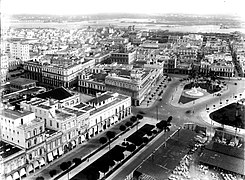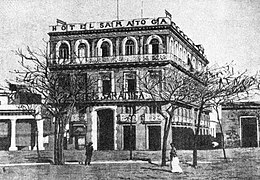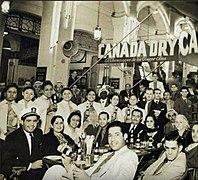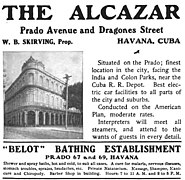
Havana is the capital and largest city of Cuba. The heart of the La Habana province, Havana is the country's main port and leading commercial center. The city has a population of 2.1 million inhabitants, and it spans a total of 781.58 km2 (301.77 sq mi) – making it the largest city by area, the most populous city, and the fourth largest metropolitan area in the Caribbean region.

El Capitolio, or the National Capitol Building, is a public edifice in Havana, the capital of Cuba. The building was commissioned by Cuban president Gerardo Machado and built from 1926 to 1929 under the direction of Eugenio Rayneri Piedra. It is located on the Paseo del Prado, Dragones, Industria, and San José streets in the exact center of Havana.
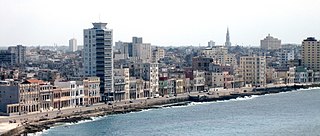
The Malecón is a broad esplanade, roadway, and seawall that stretches for 8 km along the coast in Havana, Cuba, from the mouth of Havana Harbor in Old Havana, along the north side of the Centro Habana neighborhood and the Vedado neighborhood, ending at the mouth of the Almendares River. New businesses are appearing on the esplanade due to economic reforms in Cuba that now allow Cubans to own private businesses.

La Mansión de Mark Pollack, is a neo-classical, Florentine mansion in the Cubanacan Section of Havana, Cuba built in 1930 by the Cuban architect, Leonardo Morales y Pedroso (1887–1965). It is located at 21st street #15001, Cubanacan, Havana, Cuba. It was built for Mark Alexander Pollack (1874–1946),the son of Alexander Pollack and Belle A. Rothschild (1848-1936), the American-born patriarch of a wealthy Cuban tobacco exporter. The house covers an area of 13,000 square meters.

Paseo del Prado is a street and promenade in Havana, Cuba, near the location of the old city wall, and the division between Centro Habana and Old Havana. Technically, the Paseo del Prado includes the entire length of Paseo Martí approximately from the Malecon to Calle Máximo Gómez, the Fuente de la India fountain. The promenade has had several names; it was renamed Paseo de Martí in 1898 with the island's independence from Spain. Despite the historic references, the people of Havana simply call it "El Prado".
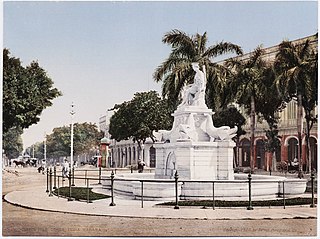
Fuente de la India is a fountain by Giuseppe Gaggini in Havana, Cuba, at the south extreme of Paseo del Prado, about 100 m south of El Capitolio, between Monte and Dragones Streets. The figure represents the Indian woman "Habana" in whose honor Havana was named.
The following is a timeline of the history of Havana, Cuba.

The Parque Central, Havana is one of the best known and central sites of the city of Havana, Cuba. It is located between Prado, Neptuno, Zulueta and San José streets, and San Rafael Boulevard. Among the buildings surrounding the park are Gran Teatro de La Habana, the Hotel Inglaterra, the Hotel Telégrafo, el Hotel Parque Central, la Manzana de Gómez, the Hotel Plaza and Museo Nacional de Bellas Artes.
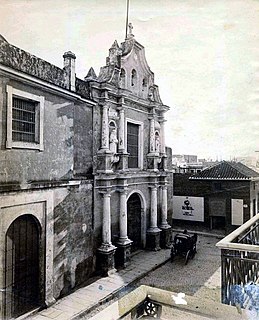
The Iglesia de San Francisco de Paula, Havana is part of the ecclesiastical heritage of Havana. It is located at 110 Calle Leonor Pérez on the corner of Calle San Ignacio. It is near the bay on the south side of Havana Vieja."

The Alameda de Paula is a promenade in Havana, Cuba, and was the first to be built in the city.
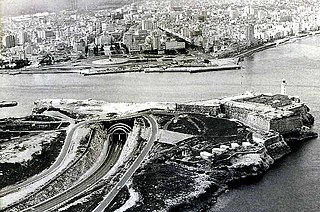
Havana Tunnel is a route under the Havana Bay, built by the French company Societé de Grand Travaux de Marseille between 1957-58. The president of the Republic Fulgencio Batista planned to expand the city to Habana del Este by building a new suburb with large avenues and luxury buildings, and a new connection between Havana Vieja and the east side across Havana Bay was required.

The Parque de la Fraternidad is a park in Havana, Cuba. It was built in the 1790s as a military practice range by the Spanish government; it was expanded in 1793 by Belgian engineer Agustin Cramer, and later the Bishop Espada improved the lighting of the Campo. It was Captain General Don Miguel Tacón who included it within the scope of his embellishment program. The area was then fenced and four majestic gates, crowned with coats of arms, each representing an important personality: the north gate, Hernán Cortés; the south one, Francisco Pizarro; and the east and west gates, Captain General Miguel Tacón y Rosique (1834-1838), and Christopher Columbus respectively.

The Colegio de Belén located between 45th and 66th streets – situated next door to the Tropicana nightclub – in Marianao, Havana, was designed in 1925 by the architect Leonardo Morales y Pedroso and his brother the engineer Luis Morales y Pedroso of the firm Morales y Compañía Arquitectos.

Built in 1875, in the Reparto de las Las Murallas,, it was the work of the architect Eugenio Rayneri y Sorrentino. Around 1880 the mansion was owned by the Count of Casa Moré. The “La Flor de José Murias” tobacco factory was installed in the building. Later, through the exploitation of rents, it became a tenement house. In 1951 some of its spaces were dedicated to housing. On its upper floor, the Spanish Center and the Israeli Center of Cuba had their headquarters.

The Royal Palm Hotel is a former hotel in Havana, Cuba, on the corner of San Rafael and Industria. It was designed by the architect Horacio Navarrete in 1926.

The Hotel Perla de Cuba in Havana was the first commercial hotel in Cuba, it was situated on the corner of Dragones and Amistad in the municipality of Centro Habana.

The Hotel San Carlos was a tall, narrow, seven-story building. With a privileged location in front of the Plazuela de las Ursulines at the intersection of Avenidas Belgica (Egido) and Máximo Gómez (Monte).

The Hotel Pasaje was a hotel located on Paseo del Prado between San José and Dragones, facing the National Capitol in Havana, Cuba.
Antonio Fernandez de Trebejos and Zaldivar was an 18th-century architect, colonel of engineers in the Spanish army, author of some of the most notable Havana buildings of the colonial era.

On May 6, 2022, Hotel Saratoga, a five-story luxury hotel in the Old Havana municipality of La Habana, Cuba, suffered a suspected gas explosion that damaged large portions of the building as well as surrounding infrastructure. 46 people died in the explosion, along with 97 more injuries. The hotel was undergoing renovations and there were no guests; however, there were fifty-one workers inside.



